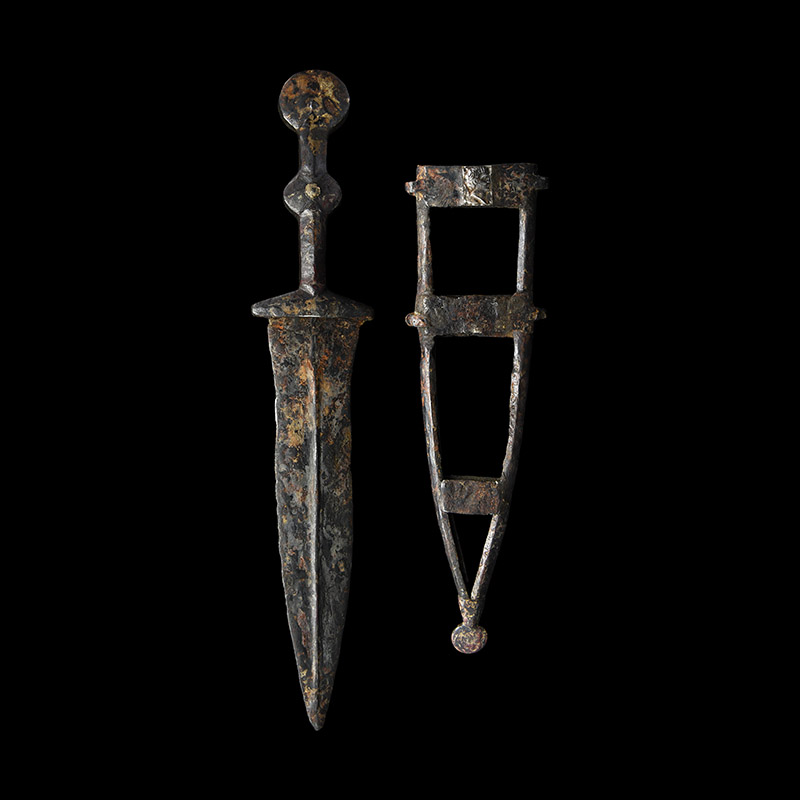Home > Stories by TimeLine Auctions
Stories by TimeLine Auctions
TimeLine Auctions - “Et tu, Brute?”
The pugio, renowned in literature as the hidden weapon carried by each of the conspirators who assassinated Julius Caesar, was also the battle dagger most favoured by the Roman legionary when he fought at close-quarters on bloody battlefields across the Empire. It is thought that the Romans first encountered foes armed with short, triangular bladed daggers with two-disc hilts during their decades of savage warfare against the Celtiberians in Spain. The long war culminated in an eight-month blockade of Numantia, a tribal city where many of the inhabitants chose suicide rather than submission to their Roman enemies. Most died by stabbing themselves with their own daggers. The victors at Numantia no doubt picked the daggers up as battlefield trophies and caried them home.
They were then copied by Roman military smiths, and had formed part of the standard legionary's kit by the time of the battle of Alesia (52 BC). The pugio was used, like the Celtiberian dagger, for fighting in close-quarters and for dispatching fallen enemies. It gained a high reputation as a valued back-up weapon suited to certain types of combat where it was primarily used when making stabbing thrusts.
The popularity of this artefact as a collectors’ item has inevitable attracted fake makers. At TimeLine Auctions we have, in the past, featured several genuine pugiones as auction lots. We urge potential buyers to turn to the pages of our auction catalogues where they can study high quality photographs that depict this and other ancient weaponry in museum quality images. Lot 0470 in our 2nd June 2020 Auction makes an excellent starting point for any would-be collector wishing to avoid fakes and make a secure start by taking part in a TimeLine Auction. The catalogue description of Lot 0470 reads:
 Roman Pugio with Scabbard. 2nd-1st century B.C.
Roman Pugio with Scabbard. 2nd-1st century B.C.
An iron pugio military dagger of Type I from the Republican period, comprising a short triangular blade with thick midrib and swept edges, narrow point, triangular guard with chamfered upper edges, grip with facetted bulb displaying a bronze stud and disc pommel; frame of the accompanying scabbard with C-section outer edges and three flat transverse bracers, chape with disc finial, four attachment loops for mounting straps, to the obverse of the mouth an applied repoussé silver portrait bust with Julio-Claudian hairstyle. Sold for £3,500 inc B.p.
Footnotes:
1 ..Type I pugio daggers are typically 28-30 cm in length, the earliest and shortest of the type. The two discs that form the grip and pommel confirm its origins among a class of combat knives found on the Iberian Peninsula before the first Roman military invasion. The overall design was borrowed from the contemporary Celtiberian double-disc-handled dagger. These may initially have been taken from defeated local warriors as battlefield booty from the Numantine and Sertorian Wars (153-133 B.C. and 75 B.C. respectively).
2 .. Antiquities lovers collecting on slimmer budgets should study TimeLine Auctions pages offering fragmented Roman weaponry, where a blade-tip, or a chape from a pugio might feature as an inexpensive lot. Each will have received the same detailed inspection to ensure that fakes do not feature in our auctions.
Aaron Hammond (Chief Operating Officer), TimeLine Auctions, 6th April 2023




